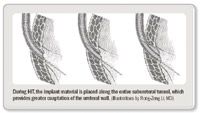Article
Endoscopic Tx of VUR shows cure rates above 90%
Atlanta--Children treated with endoscopic intervention for vesicoureteral reflux continue to demonstrate cures that approach those of open surgery and have a high resolution rate after initial failure. In addition, incidence of febrile and non-febrile urinary tract infection after treatment is lower than after surgery, according to data presented here at the State-of-the-Art Symposium on Pediatric UTI, Reflux, Antibiotic Resistance, and Endoscopy.

Andrew J. Kirsch, MD, clinical professor of urology at Children's Healthcare of Atlanta, Emory University School of Medicine, previously reported data in 285 children who had undergone endoscopic intervention with the injectable agent dextranomer/hyaluronic acid copolymer (Deflux, Q-Med, Uppsala, Sweden), between October 2001 and October 2003. Dextranomer/hyaluronic acid, approved for use in the United States in 2001, is a newer polymer available for the endoscopic treatment of VUR as an alternative approach to open surgery and chronic antibiotic use.
Dr. Kirsch and colleagues introduced a modified subureteric transurethral injection (STING) procedure (implantation submucosally within the intramural ureter) during the last year of that study (J Urol 2004; 171:2413-6). After one endoscopic treatment, 137 of 181 cases (76%) were cured (grade 0 reflux), while 24 of 44 (54%) of the failures were improved. The overall cure rate was 94% for grade I, 85% for grade II, 78% for grade III, and 71% for grade IV reflux. The ureteral success rate for the modified STING procedure was better than that seen with the traditional STING procedure: 90% of patients (92% of ureters) versus 71% of patients (79% of ureters, (p<.01).

Continued improvement The latest data indicate a high resolution rate upon a second injection after initial failure. Between May 2002 and May 2004, 42 children (37 girls and five boys; mean age, 5 years) underwent a second injection with dextranomer/hyaluronic acid copolymer. Out of 39 patients, 35 (90%) had resolution of VUR (86% with bilateral VUR and 92% with unilateral VUR). Resolution was achieved in 47 out of 53 ureters (89%): 88% with grade I VUR; 92% with grade II VUR, and 85% with grade III VUR.
"Since our last publication, the results have continued to improve," Dr. Kirsch said. "Two changes have contributed to this trend. The first is that all patients are now treated with the hydrodistention-implantation technique (HIT; loss of hydrodistention is used to confirm a successful implantation). And if the ureteral tunnel is not completely coapted, a more distal HIT (termed 'double HIT') is performed. Then, if the ureteral orifice is still not coapted, a classic STING approach is used."
Dr. Kirsch also points out that a greater volume of dextranomer/hyaluronic acid copolymer is now used. In the initial analysis, a mean volume of 0.9 mL was injected.
"Now, at least 1 mL is used per ureter, with increasing volumes up to 1.8 mL as VUR grade and hydrodistention grade increase," he said.
















